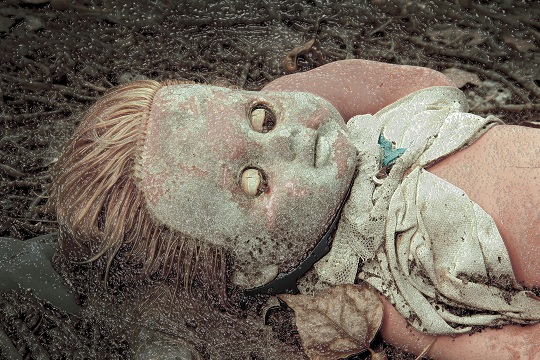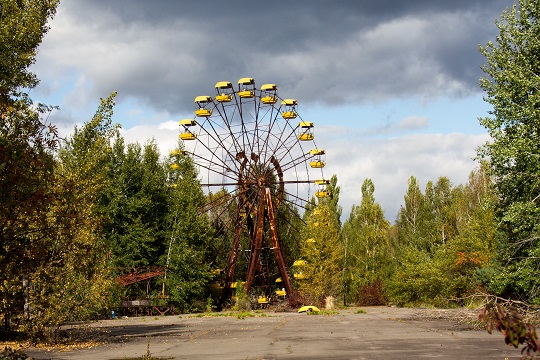Children of the Nuclear Disaster
Freiburg, Jan 25, 2021
The nuclear disaster in Chernobyl has followed Melanie Arndt, Professor of Economic, Social, and Environmental History at the University of Freiburg, since she was a child. When she was still in school, she helped children who had been directly affected by the reactor disaster in the Ukrainian town of Chernobyl in her hometown of Wittenberg. After she graduated from school, she joined the Action Reconciliation Service for Peace (ARSP) and went to Minsk, Belarus, to work as a volunteer in the civic initiative helping the “Chernobyl children,” as they are called. She then completed her master’s degree and earned a PhD, writing her thesis on health care policies in the divided city of Berlin. Since then, she has written several books about the consequences of the nuclear disaster. Her most recent book “Chernobyl Children” shines a light on the international management of the humanitarian aid. During a time when East and West were bitter enemies caught up in the Cold War, the children of Chernobyl became, as Arndt writes, “children of the whole planet.”
 An abandoned kindergarten in the oblast of Kiev. Many people who were sent abroad as children to recuperate from the Chernobyl disaster talk about memories that often reflect contradictory experiences of that time. Photo: Ruslana/stock.adobe.com
An abandoned kindergarten in the oblast of Kiev. Many people who were sent abroad as children to recuperate from the Chernobyl disaster talk about memories that often reflect contradictory experiences of that time. Photo: Ruslana/stock.adobe.com
Arndt’s study focuses primarily on what she describes as the “social and political effects of the nuclear disaster that coincided with the end of a world order,” when the world was no longer divided into two opposing camps in the Cold War. The historian chose the so-called Chernobyl children as an indicator of the many different consequences of this encounter. After the nuclear disaster in 1986, children were sent away to uncontaminated areas in Ukraine and abroad for health reasons. A network of Soviet and foreign initiatives as well as non-government organizations was soon established to organize these holidays to let the children recuperate. As Arndt argues in her book, “Humanitarian aid is a form of politics. It became particularly clear that transnational networks had a considerable influence on helpers’ strategies. If nothing else, they contributed to overcoming the Cold War.”
“Chernobyl children” is a term often used in many situations. It is even used generally for children in areas most affected by radiation. However, Arndt uses the term solely for the children who were sent away to recuperate after the disaster. It is estimated that there were more than one million Chernobyl children, but the exact number is not known. In the beginning, children from the areas most affected by radioactive fallout – Belarus and Ukraine – were sent to other areas within the Soviet Union, where a majority of them were housed in repurposed holiday camps. However, most of the children wanted to go abroad, where they often lived in host families. Of these Chernobyl children, many were sent to Italy to recuperate, followed by Germany. They were also sent to Cuba as well as the US and many other Western countries.
Staying with the Enemy
Ideological differences were not an obstacle for sending kids abroad, says Arndt; rather, the opposite was the case: “The host families were very curious. They wanted to know who these people were that the media had said were their enemies for so long. They also wanted to help these children who had suffered so much. That they wanted to show them which system they thought was the best made it all the easier for them to help.”
 An amusement park was set to open in the town of Pripyat, close to the nuclear reactor, just after the disaster. Today, Pripyat is a ghost town. Photo: Crystoll/stock.adobe.com
An amusement park was set to open in the town of Pripyat, close to the nuclear reactor, just after the disaster. Today, Pripyat is a ghost town. Photo: Crystoll/stock.adobe.com
And how did the children feel about staying with the enemy? “While certainly ambivalent, this experience was primarily a positive one,” says the historian, adding: “People’s stories should be taken with a grain of salt, however, in particular because the media mainly wrote about and showed pictures of success stories. Kids who had a negative experience didn’t or don’t talk about it.”
Arndt finds it remarkable that many Chernobyl children have positive memories of the time when the nuclear reactor disaster happened and they were sent away. “The traumatic experience of the Chernobyl disaster is kind of rosy in hindsight,” she says. They say things like “I got to know a new culture when I was abroad,” or “I became a cosmopolitan while I was there. I saw the world and learned a new language.” However, as she says, “They soon begin to talk about some of the negative things and the suffering. These contradicting experiences are tightly interwoven. Perhaps this can be regarded as a strategy for coping with the trauma.”
Exploring New Worlds
For many of the adults accompanying the children on these stays, it was a chance to get to know the West. “It’s important to acknowledge that their work with the children was also an opportunity for them to find meaning in a society that was collapsing, whether this was a conscious decision or not,” she says. For many of them, it meant new career opportunities and a new direction in their lives. As an example, Arndt mentions the story of one leader in the Komsomol (the Soviet youth organization). After the fall of socialism, he put his leadership experience and talents to work in a welfare organization partially funded by the government.
Arndt believes that the work done by the numerous organizations that were founded in the late 1980s and the partnerships with Western initiatives played an important role in the development of civil society structures in Belarus and Ukraine. “In the West, helping Chernobyl children also gave thousands of small initiatives and individuals a new purpose: They were needed and they could also discover new worlds.”
Hans-Dieter Fronz

